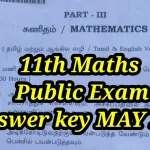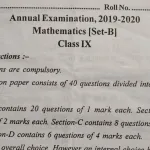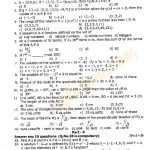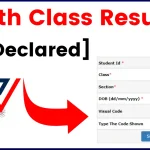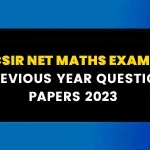Understanding science concepts is crucial for students in Class 8. This educational resource provides questions and answers based on the 2019 government question paper. It includes diverse topics and concepts, ensuring comprehensive knowledge for exam preparation. Clear and concise answers help students strengthen their understanding and boost confidence.
Physics Questions and Answers
Question: What is the speed of light in a vacuum?
Answer: The speed of light in a vacuum is approximately 3 × 10⁸ meters per second.
Question: Define the term force.
Answer: Force is a push or pull acting upon an object due to its interaction with another object.
Question: What is gravitational force?
Answer: Gravitational force is the force of attraction between two objects with mass.
Question: What is energy?
Answer: Energy is the ability to do work or cause change.
Question: Define work in terms of physics.
Answer: Work is done when a force is applied to an object and the object moves in the direction of the force.
Question: What is friction?
Answer: Friction is the resistance to motion when one object moves against another.
Question: Define acceleration.
Answer: Acceleration is the rate of change of velocity of an object.
Question: What is the unit of force in the SI system?
Answer: The unit of force in the SI system is the newton (N).
Question: What is a simple machine?
Answer: A simple machine is a device that makes work easier by multiplying force or changing its direction.
Question: Define pressure.
Answer: Pressure is the force exerted per unit area.
Question: What is a vacuum?
Answer: A vacuum is a space devoid of matter, including air.
Question: What are the three states of matter?
Answer: The three states of matter are solid, liquid, and gas.
Question: What is kinetic energy?
Answer: Kinetic energy is the energy possessed by an object due to its motion.
Question: Define potential energy.
Answer: Potential energy is the energy possessed by an object due to its position or configuration.
Question: What is a lever?
Answer: A lever is a simple machine consisting of a rigid bar pivoted at a fixed point called the fulcrum.
Question: What is inertia?
Answer: Inertia is the property of an object to resist changes in its state of motion or rest.
Question: Define velocity.
Answer: Velocity is the speed of an object in a specific direction.
Question: What is a renewable energy source?
Answer: A renewable energy source is one that is naturally replenished, such as solar or wind energy.
Question: What is the boiling point of water in Celsius?
Answer: The boiling point of water in Celsius is 100 degrees.
Question: Define the term heat.
Answer: Heat is a form of energy that is transferred between objects due to a temperature difference.
Chemistry Questions and Answers
Question: What is an element?
Answer: An element is a pure substance made of only one type of atom.
Question: Define compound.
Answer: A compound is a substance formed when two or more elements chemically combine in fixed proportions.
Question: What is a chemical reaction?
Answer: A chemical reaction is a process in which substances interact to form new substances.
Question: Define acid.
Answer: An acid is a substance that releases hydrogen ions (H⁺) in a solution.
Question: What is a base?
Answer: A base is a substance that releases hydroxide ions (OH⁻) in a solution.
Question: What is pH?
Answer: pH is a measure of the acidity or alkalinity of a solution.
Question: Define oxidation.
Answer: Oxidation is the loss of electrons during a chemical reaction.
Question: What is a molecule?
Answer: A molecule is the smallest unit of a chemical compound that retains its chemical properties.
Question: Define atomic number.
Answer: Atomic number is the number of protons in the nucleus of an atom.
Question: What is a periodic table?
Answer: The periodic table is a tabular arrangement of chemical elements based on their atomic number.
Question: What are isotopes?
Answer: Isotopes are atoms of the same element with different numbers of neutrons.
Question: What is a chemical bond?
Answer: A chemical bond is a force that holds atoms together in a molecule or compound.
Question: Define catalyst.
Answer: A catalyst is a substance that increases the rate of a chemical reaction without being consumed.
Question: What is electrolysis?
Answer: Electrolysis is a process in which electrical energy is used to drive a chemical reaction.
Question: What is the atomic mass unit?
Answer: The atomic mass unit is a standard unit used to measure the mass of atoms and molecules.
Question: Define valency.
Answer: Valency is the combining capacity of an atom to form chemical bonds.
Question: What is a salt?
Answer: A salt is an ionic compound formed by the neutralization of an acid with a base.
Question: Define mixture.
Answer: A mixture is a combination of two or more substances that are not chemically bonded.
Question: What is distillation?
Answer: Distillation is a process used to separate components of a mixture based on their boiling points.
Biology Questions and Answers
Question: What is a cell?
Answer: A cell is the basic structural and functional unit of life.
Question: Define photosynthesis.
Answer: Photosynthesis is the process by which green plants use sunlight to synthesize food from carbon dioxide and water.
Question: What is respiration?
Answer: Respiration is the process by which organisms release energy from food.
Question: Define organ.
Answer: An organ is a group of tissues that work together to perform a specific function.
Question: What is a habitat?
Answer: A habitat is the natural environment where an organism lives.
Question: Define ecosystem.
Answer: An ecosystem is a community of living organisms and their physical environment interacting as a system.
Question: What is a food chain?
Answer: A food chain is a sequence of organisms where each is eaten by the next.
Question: Define biodiversity.
Answer: Biodiversity refers to the variety of life forms on Earth.
Question: What are vertebrates?
Answer: Vertebrates are animals that have a backbone.
Question: What is the function of chlorophyll?
Answer: Chlorophyll absorbs sunlight for photosynthesis.
Question: Define pollination.
Answer: Pollination is the transfer of pollen from the male part of a flower to the female part.
Question: What are enzymes?
Answer: Enzymes are biological molecules that speed up chemical reactions in living organisms.
Question: What is the function of the heart?
Answer: The heart pumps blood throughout the body.
Question: Define reproduction.
Answer: Reproduction is the biological process by which organisms produce offspring.
Question: What is a carnivore?
Answer: A carnivore is an animal that eats other animals.
Question: Define herbivore.
Answer: An herbivore is an animal that eats plants.
Question: What is an omnivore?
Answer: An omnivore is an animal that eats both plants and animals.
Question: What is the function of roots in plants?
Answer: Roots absorb water and nutrients and anchor the plant to the soil.
Question: Define adaptation.
Answer: Adaptation is the process by which organisms adjust to their environment.
Ending Summary: Preparing for science exams becomes easier when students have access to diverse and clear questions and answers. This educational guide simplifies complex concepts and covers essential topics from Class 8 government question papers. The goal is to help students achieve better understanding and performance.
Latest Posts
- Step-by-step guide to download and apply for jee mains admit card 202
- Comprehensive 2025 government holidays and recruitment details for job seekers
- JEE Mains Admit Card 2025: Your Step-by-Step Guide to Downloading the Hall Ticket
- Everything You Need to Know About 2025 Government Holidays Recruitment
- Comprehensive Guide to rrb d group recruitment 2025 – Eligibility, Vacancies, and Application
- Detailed guide to nps trust recruitment 2025 vacancies, eligibility and apply process
- Comprehensive guide to hpcl recruitment 2025 notification, vacancies, and application process
- ignou bed admission 2025 complete recruitment guide with eligibility and process
- Comprehensive Guide to Indian Army Agniveer Recruitment 2025 Notification and Jobs
- Everything You Must Know About CBSE Board Exams 2025 Changes & New Rules


